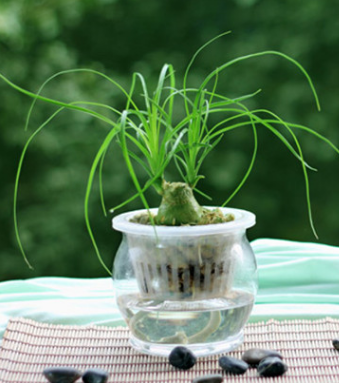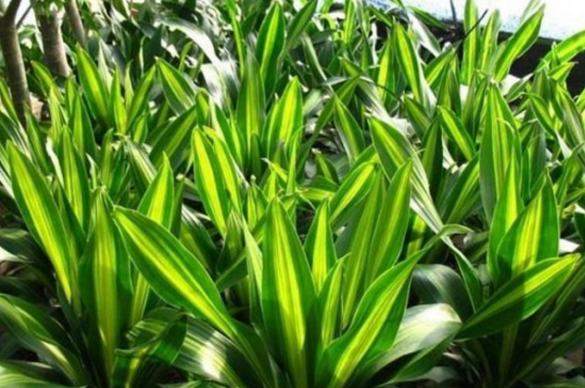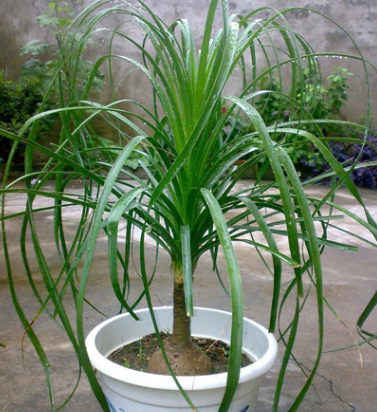How to correct hydroponic culture of wine bottle orchid when to blossom and flower language
Wine bottle orchid, also known as elephant leg tree, false leaf tree family. Small evergreen trees belonging to foliage plants. Native to hot and dry areas of Mexico. Wine bottle orchid is a tree-shaped succulent plant. It looks like a large wine bottle, so it becomes a very strange decorative plant.

How to correctly cultivate wine bottle orchid in water
1. Water culture of bottle orchid to obtain seedlings.
Choose a perennial, disease-free, straight single-headed wine bottle orchid or a mini plant with more terminal buds, then dig it out of the basin or on the ground, remove the upper part of the soil, pay attention to protect the roots, then clean it with water, cut off the rotten roots or weak roots, and soak them in diluted flower and plant nutrient solution for a day.
2. wine bottle orchid water culture to take volume bottle
Bring two double-layer bottles, the upper bottle should have a bottom hole plastic screen, while the base bottle needs to be non-bottom hole plastic bottle or glass bottle.
3. Hydroponic culture method of wine bottle orchid.
Dig four or five small holes of about one centimeter at the bottom of the upper bottle, plant the wine bottle orchid soaked in the nutrient solution of flowers and plants in the upper bottle, and the root should be pierced into the bottom hole of the upper bottle and put into ceramsite. Then stabilize the wine bottle orchid, put it on the grass-roots bottle, and put in the clear water and flower nutrition solution. The water should reach the bottom of the upper bottle, and then place it in a cool place.
4. Water culture management of wine bottle orchid.
Spray wine branches and leaves with diluted flower and plant nutrient solution every three days, change the water every half a month, and add flower and plant nutrient solution at the same time. After half a month in the pot, it can take root. In fact, hydroponic culture is a little more hygienic than soil culture. if there is less water, you can add water every 5-6 days, and hydroponics will cause fewer diseases and insect pests.
When will the bottle orchid blossom
1. Will the bottle orchid blossom
Will the wine bottle orchid blossom? it is certain that the wine bottle orchid will blossom, but it will take a long time for the wine bottle orchid to blossom, so it is very rare.
Generally speaking, when breeding, flowering can only be achieved after the environmental conditions such as temperature and light and the accumulation of nutrients in the plant are sufficient. Some people say that this process takes a long time and is generally possible only after 60 years of planting. In fact, although wine bottle orchid flowering is relatively rare, but generally more than 10 years of plants have the possibility of flowering, if properly maintained, you can see the unique flowers of wine bottle orchid in advance.
The bottle orchid blossoms, like most tequila plants, is very strange. When blooming, the wine bottle Lanmi white florets bloom densely on the flower branches, and the loose panicle is very spectacular. And these flowers will also exude a strange fragrance, can attract butterflies and bees.
2. The floral language of wine bottle orchid
Is to be generous.
Culture method of hydroponic cyclamen
The flower language of cyclamen has the meaning of welcoming distinguished guests and hospitality, so it is a kind of flower which is very suitable for putting in the living room, which can make visitors feel at home. On the other hand, hydroponic cyclamen gives people a sense of freshness and clearness, and it is easier to cultivate cyclamen than soil cyclamen.
The culture method of hydroponic cyclamen
[plant archives]-
English name: cyclamen
Scientific name: Cyclamen persicum
Alias: radish begonia, rabbit ear flower, rabbit flower, first crown, bonspark, petal lotus
Family: Myrsinaceae of Taurus family
Genus: cyclamen Cyclamen
Distribution of origin: cyclamen originated in Greece, Syria and other Mediterranean regions, northern Africa and Asia minor. It was introduced to Paris in Europe in 1620, while in England it was not cultivated until 1731 and spread to China in 1840.
Morphological characteristics: cyclamen is a perennial herb. The diameter of underground oblate fleshy corm is 4-12cm. It germinates at the end of winter and blossoms in autumn. Flowers solitary, with long stalks, purplish red, red, pink and white, with purplish red spots at the base of perianth; leaves heart-shaped, grayish green, with silver-gray patterns.
Cyclamen culture method: plant and container selection-
Cyclamen should be selected from 1-3-year-old healthy, healthy and budding cyclamen plants, and it is best to choose those that have been cultivated in soilless culture substrates (perlite, vermiculite, sawdust, etc.). Cyclamen can not hurt roots, slow seedlings and adapt faster after changing the environment.
The choice of containers is simple and convenient, as long as they can hold water, such as fish tanks, teacups, beverage boxes, wine bottles and vases. The transparent container is the best from the appearance, which can fully enjoy the roots, stems, leaves, flowers and fruits of cyclamen. The basic principle of container selection is that its size, height and color should be consistent with cyclamen plants, highlighting the exquisitely carved, crystal and elegant charm of water-raised cyclamen.
Cyclamen culture method: water culture time, method-
According to the florescence of cyclamen is generally from October to June of the following year, it is decided that the best time for hydroponic culture of cyclamen is from September to April of the second year, slightly ahead of the flowering period of 1-2 months.
The selected cyclamen plants were removed from the pot, and under the premise of not hurting the roots, the matrix adhered to by the roots was washed with about 20 ℃ of warm water and put directly into the container. The water depth in the container is flush with the rhizosphere, and the maximum depth should not exceed 1 stroke 3 of the corm, otherwise it will cause the corm to rot. Put the treated hydroponic cyclamen in the right place in the room and add water and nutrient solution regularly. After the cyclamen flower failed, it was taken out to the cultivation medium for the summer.
Cyclamen culture methods: requirements for water quality and water temperature-
Hydroponic cyclamen had better use mountain spring water or magnetized water, whose water quality is clean and contains a variety of trace elements necessary for plants, which can ensure that there is no need to change water during the whole hydroponic period. On the other hand, tap water contains chlorine that is disadvantageous to the growth of flowers, so it is easy to muddy and precipitate, so it needs to be changed every few days.
The water temperature can be kept close to the indoor temperature at that time, usually at 10-20 ℃.
Cyclamen culture methods: requirements for light and indoor temperature-
Cyclamen likes a sunny environment and should be placed on a sunny table or windowsill indoors, but people in the north should be careful not to bake cyclamen directly on the radiator.
The most suitable indoor temperature is 15-20 ℃, the highest is not more than 25 ℃ and the lowest is not less than 10 ℃.
The culture method of cyclamen: the addition of nutrient solution-
Hydroponic cyclamen should be replenished regularly during flowering. Generally, according to the unit of each cyclamen, 100 times of 50ml is added to each plant every 10 days. If you prepare your own nutrient solution, you should also use mountain spring water instead of tap water.
If you find cyclamen leaves yellow, leaves small, flowers small and other phenomena, in the case of excluding rotten roots, you can add more nutrient solution as appropriate.
Conclusion: the aquaculture methods of hydroponic cyclamen are all of these contents, which is still very simple and easy. However, the rhizome of cyclamen has a certain toxicity, vomiting and diarrhea after eating, skin contact will cause redness and swelling, so you should pay extra attention to it during cultivation.
[related recommendations]
Is the tequila culture method bedroom? > are calla lilies poisonous? plant culture techniques Canna culture methods of rich trees
Cultivation method of sunflower planted by Dendrobium candidum how to raise tiger orchid, how to raise Guanyin lotus in winter, how to grow iris
The effect and function of Kunlun snow chrysanthemum the culture method of crab claw orchid
- Prev

What are the correct aquaculture methods of Brazilian iron? hydroponics and fancy words
Brazilian iron, also known as fragrant dragon blood tree, is an evergreen tree of the genus fragrant dragon blood of Liliaceae, which can be up to 6 meters high. It is native to western Africa and is distributed and planted in Yunnan, Guangxi, Hainan and other places in China. Brazilian iron has become a common ornamental cultivated woody plant in families. What is the light of Brazilian iron in the culture method of Brazilian iron
- Next

How to propagate wine bottle orchid? what are the fengshui effects?
Many flower friends use the method of cutting to propagate the wine bottle orchid, but what is the cutting substrate of the wine bottle orchid and how to choose the branches. A series of questions, so how to cut in the end? let's take a look at it. How to propagate bottle orchid temperature management of cuttings of bottle orchid
Related
- Fuxing push coffee new agricultural production and marketing class: lack of small-scale processing plants
- Jujube rice field leisure farm deep ploughing Yilan for five years to create a space for organic food and play
- Nongyu Farm-A trial of organic papaya for brave women with advanced technology
- Four points for attention in the prevention and control of diseases and insect pests of edible fungi
- How to add nutrient solution to Edible Fungi
- Is there any good way to control edible fungus mites?
- Open Inoculation Technology of Edible Fungi
- Is there any clever way to use fertilizer for edible fungus in winter?
- What agents are used to kill the pathogens of edible fungi in the mushroom shed?
- Rapid drying of Edible Fungi

